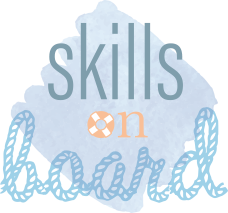Module 1 The new touristic profiles
November 21, 2019Module 3 The cultural context of the yacht trip
November 21, 2019Module 2 The skipper profile
What is addressed in this module
Tourism is changing and these changes demand new skill sets from the modern-day skipper. The modern skipper profile will need to adapt by learning these new skills and the aim of this module will give a comparison of the typical profile of the traditional skipper vs the modern-day skipper. This module is presenting the role and responsibilities of the traditional skipper and showing in comparison how the demands of the modern tourist, who enjoy skippered charter as part of their holiday experience, has changed the role and skill set of the modern skipper.
Learning objectives
By the end of this module you will be able to:
- Understand what a typical traditional ships captain profile might look like,
- Understand what the New Skipper profile might be,
- Identify the main differences between the two profiles?

The captain is responsible for the safe and efficient operation of the ship and its people and cargo, including its seaworthiness, safety and security, cargo operations, navigation, crew management, and legal compliance.
The captain ensures that the ship complies with local and international laws and complies also with company and flag state policies. The captain is also responsible, under the law, for aspects of operation such as the safe navigation of the ship, its cleanliness and seaworthiness, safe handling of all cargo, management of all personnel, inventory of ship’s cash and stores, and maintaining the ship’s certificates and documentation.
One of a shipmaster’s particularly important duties is to ensure compliance with the vessel’s security plan, as required by the International Maritime Organization‘s ISPS Code. The plan, customized to meet the needs of each individual ship, spells out duties including conducting searches and inspections, maintaining restricted spaces, and responding to threats from terrorists, hijackers, pirates, and stowaways. The security plan also covers topics such as refugees and asylum seekers, smuggling, and saboteurs.
On ships without a purser, the captain is in charge of the ship’s accounting. This includes ensuring an adequate amount of cash on board, coordinating the ship’s payroll (including draws and advances), and managing the ship’s slop chest.
The traditional skipper profile above still widely exists, it mainly does so for larger merchant and passenger ships.
From the point of view of a passenger cruising on a passenger ship, the traditional captain is someone you might meet when boarding or disembarking or perhaps during an evening event during the cruise. Otherwise, he would be not on view during the normal working/cruising day.
The New Skipper:
Over the last decade a new breed of skipper has evolved, ‘The charter yacht skipper’.
In simple terms the modern skipper’s responsibilities are very similar to that of the traditional skipper regarding the safety of the ship and its passengers, but due to the nature of the growing charter business, the skipper is required to possess a new range of skills and competences (not currently offered in skipper training programs) in order to deal with the changes and challenges this growth sector demands.
Whilst a typical passenger cruise ship may reach a length of 300 meters or more, the growing charter boat sector mainly offers charter on vessels from 15 meters to 50 meters and these vessels can be either sail or power-driven.
Due to this size difference of the ship, the main effect is that the charter skipper works in much closer proximity to the charter guests and as such must possess a broader range of skills to interact with the passengers or guests they like to be called! Therefore, the new skipper will be more directly and actively involved in the continuous daily regime throughout the charter voyage.
The more modern charter business combined with the new trends in tourism in terms of new touristic profiles and the yacht tourism customers profile (e.g. age, education level, professional backgrounds etc.), experience tourism, adventure tourism, social and cultural dimensions, personal dimensions in yachting tourism as for example the need for challenge, adventure, escape, freedom, thrill, escapism, environmental and cultural enjoyment, recreational activities etc. and the way these trends are interconnected with the need of high quality integrated services, such as the ability to understand people’s wants and needs and satisfying them, organizing trip segments and activities, according to mood and collective character of the onboard clients/tourists, basic hospitality rules, onboard cooking/kitchen etiquette and common sensibility, basic knowledge of the historical and cultural ‘context’ of the area/places to be visited and sailed through, etc.
The new skipper’s role has identified the needs for further training to learn and acquire new sets of transversal skills and attitudes at the personal, interpersonal/societal level, as interrelated with interpersonal and communication skills as well as leadership skills and managing the onboard community.
In Conclusion:
Modern skippers will be required to possess the following skills:
Crisis Management, Dealing with Stress, problem-solving, dealing with difficult people, Interpersonal skills at work, Keeping a positive attitude, Courtesy, Negotiating Skills and a knowledge to understand Body Language.
Why?
Most modern charter vessels use boats of between 10 to 35 meters in length. These vessels are designed to cater for between 6 and 12 passengers/guests and therefore compared to a 350-meter passenger ship, there is a limit to the crew number onboard. A typical charter vessel will have a skipper and one or maybe two crew onboard. This situation means that the proximity of skipper, crew to their guests is inevitable and thus the skills required to handle this situation must be held by the personnel on board.
Secondly, modern tourists have more money, more demands and require more personal attention. The modern-day skipper must possess the skill set listed above to complete and service this growing and specialised market.





